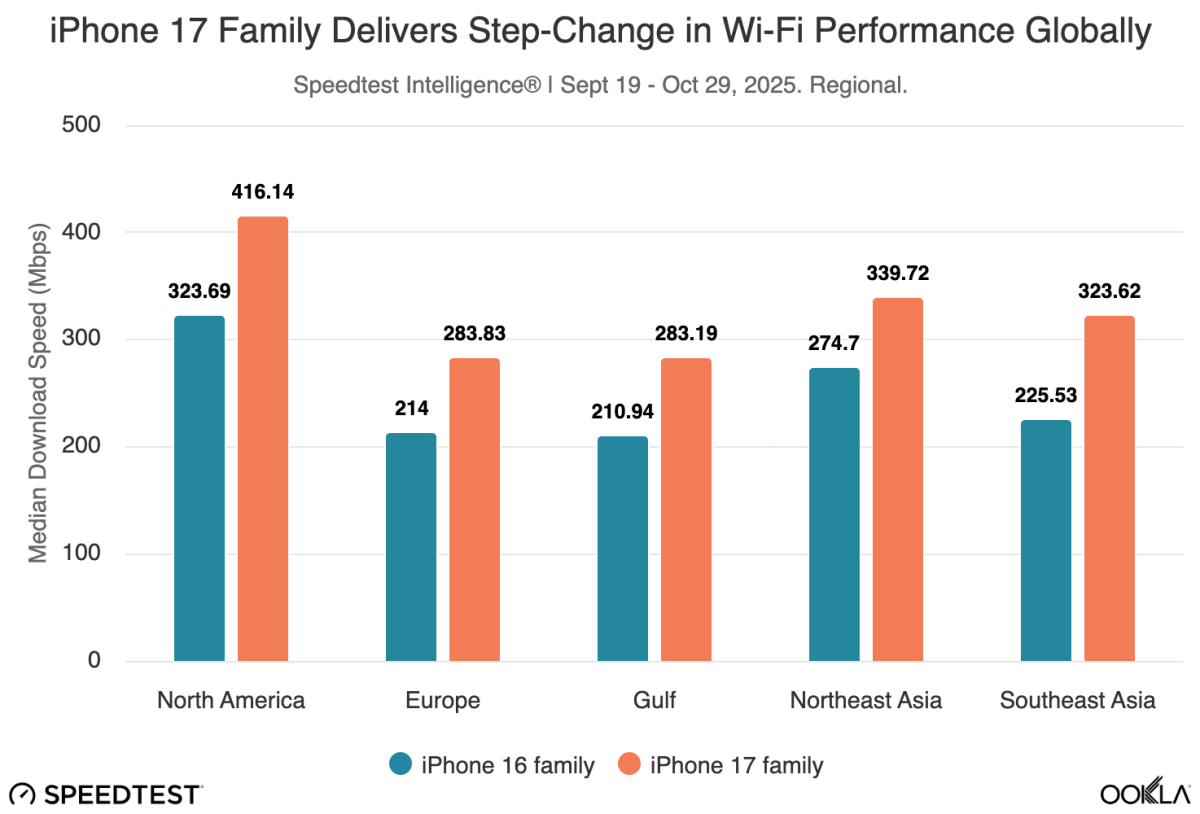|
Navigation
Recherche
|
Study: Apple’s N1 networking chip delivers a big Wi-Fi upgrade
jeudi 20 novembre 2025, 20:37 , par Macworld UK

Ookla, the company that makes the ubiquitous Speedtest.net Internet speed test, has issued a new report comparing Wi-Fi performance of Apple’s new N1 networking chip in the iPhone 17 against other Wi-Fi 7-capable phones, including the iPhone 16 and several top Android phones. The new chip is a clear winner. Not only does it make an obvious improvement in Wi-Fi performance over the Broadcom-based solution in the iPhone 16, but it catapults the iPhone 17 family to near the top of the pack for Wi-Fi 7 compatible smartphones. The results are impressive. Apple used a Broadcom chip for Wi-Fi networking, and while it offered Wi-Fi 7 support, it wasn’t really one of the fastest on the market. The N1 changes all that. Ookla In every region, Wi-Fi performance on the iPhone 17 family exceeds the iPhone 16 family. This is especially notable since both chips share the same 160 MHz channel width limitation—Apple didn’t get higher speeds by suddenly supporting the full 320 MHz bandwidth capability of Wi-Fi 7. Ookla notes that the biggest improvements over last year’s iPhones comes in the 10th percentile—the slowest connections. Similar to the C1 cellular chip, Apple seems most concerned with lifting the floor for the worst connections than with chasing the absolute top possible speeds. Ookla Apple’s improvements make it compare far more favorably to the best Android phones, globally. It doesn’t provide the fastest download speeds, but it’s in second place now, just a hair behind the Pixel 10 Pro family. It’s a big jump over the iPhone 16 family. Ookla But the iPhone 17 line beats the Pixel 10 Pro in uplink performance. It’s still not top of the pack—that honor goes to the Xiaomi 15T Pro—but it’s once again in second place and, once again, well ahead of the iPhone 16 line. Ookla While the Wi-Fi capabilities of the N1 processor in the iPhone 17 seem nearly identical to the Broadcom chip in the iPhone 16 family, it’s clear that Apple has produced a superior product. That could come down to changes in internal structure, antennas, better hardware-software integration, or a dozen other things; wireless networking is complicated. Apple still has room to grow. Use of 320 MHz channels is still quite rare, as are Wi-Fi 7 routers in general. Many countries have limited adoption of the 6GHz frequency for Wi-Fi, too. A theoretical N2 chip can implement more of the Wi-Fi 7 spec and see further improvements, in addition to maintaining better connections on slower and legacy networks. You’ll find further analysis of Wi-Fi 7 capable smartphones, and a lot more charts, on Ookla’s report.
https://www.macworld.com/article/2979894/study-apples-n1-networking-chip-delivers-a-big-wi-fi-upgrad...
Voir aussi |
59 sources (15 en français)
Date Actuelle
jeu. 11 déc. - 05:59 CET
|
 MacMusic |
PcMusic |
440 Software |
440 Forums |
440TV |
Zicos
MacMusic |
PcMusic |
440 Software |
440 Forums |
440TV |
Zicos







